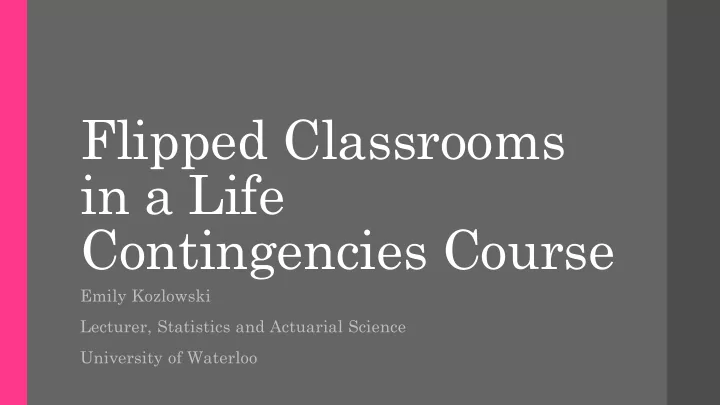

Flipped Classrooms in a Life Contingencies Course Emily Kozlowski Lecturer, Statistics and Actuarial Science University of Waterloo
Agenda • Flipped Classrooms – what are they? • Implementation in Life Contingencies 2 course • Student Feedback on the experience • Conclusions/Time for Questions
Flipped Classrooms • Students engage with lectures or other materials outside of class to prepare for an active learning experience in the classroom • Out of class tasks could be something other than online videos • Doesn’t have to be implemented for all lectures during the term • Key concept: it can be done from time to time as a way to incorporate active learning during class time to improve student engagement and understanding
Learning Activities • Out of class activities could include reviewing: assigned textbook readings certain research papers existing Youtube videos posted power point slides on LEARN • Possible in-class activities include: small-group work that engages students in discussion or problem solving debates clicker questions Q and A case studies demonstrations or simulations working through individual problems with instructor assistance and feedback
Why Flip? • Students can learn out of class materials at their own speed • Students have time to process and reflect on concepts before coming to class and applying the knowledge • Keep students focused and learning for whole class • Variety, change of pace • Instructors can identify where students are struggling • Permits adaptive instruction • Active and peer-based learning can promote deeper understanding • Can focus more on higher levels of application
Challenges • Requires advance preparation by students • Challenge to implement group work activities in large classes • May have to reduce amount of content covered • Lots of prep work the first time you implement it • Students reluctant to change to active learning activities in the classroom • Possible issues with new technology
References/Resources • Waterloo Centre for Teaching Excellence - Course Design: Planning a Flipped Class • https://uwaterloo.ca/centre-for-teaching-excellence/teaching- resources/teaching-tips/planning-courses-and-assignments/course- design/course-design-planning-flipped-class • Includes links to: Papers Activity Suggestions Assessment Suggestions
Implementation in ACTSC 331 • Course details: Life Contingencies 2 – policy values, multiple state models, joint life Required course for all ACTSC majors, no non-major students Approximately 60 students MWF 50-minute lectures • Online version of course recently developed by me, not currently offered to students
Implementation in ACTSC 331 • Students given access to module from ACTSC 331 Online in Mobius • Students review module before lecture Instructed they will be given worksheet to complete during lecture Told worksheet will be collected and possibly graded for bonus marks • In class, instructor and TA circulate to answer questions while students work together • Worksheet collected at end of class, graded out of 3 (marks added to a 10 point review quiz worth 2% of grade)
Implementation in ACTSC 331 • Implemented twice in the term, replacing two 50-minute lectures Topic 1: Expense Reserves (calculating expense premium, expense reserve, explaining sign of expense reserve/difference in GPPV and NPPV) Topic 2: Discrete transitions/transitions at exact ages in multiple decrement models (creating a MDM table that incorporates discrete transitions, calculating associated probabilities)
Things I Learned: • Quick High-Level Review at beginning unnecessary • Nominal bonus marks are a huge incentive • Students were engaged and really motivated
Student Feedback • 23 students responded to anonymous online survey after the class • “I enjoyed the flipped classroom lecture on June 4th.” 87% agree, 13% neutral • “I think I learned the material better than from a regular lecture.” 70% agree, 30% neutral
Student Feedback • 21 out of 23 respondents reviewed the online material before class • 61% stated they would have done the worksheet if there were no bonus marks offered • Comments on what worked: “Forced me to work harder/think ahead” “Actively learn the concept, not just writing down (and start reading the notes after class)” “Better understanding of knowledge” “I like how we can do the questions ourselves rather than the prof doing the question with us in class. It made me learn stuff by myself. The best thing was that i had to do it in class right away rather than procrastinating.” • Flipped classrooms were mentioned in course evaluations as effective and appropriately frequent
Conclusions • Flipping the classroom is fun for the instructor and students! • Students benefit from the active learning experience • I’ve implemented it in 3 different terms so far and always had great success • It is do-able ☺ (ACTEX Free Video Instruction Library may be coming soon??)
Recommend
More recommend